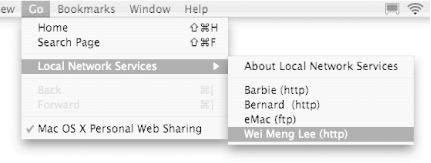8.5 Using Rendezvous with Camino
8.5 Using Rendezvous with CaminoCamino is an alternative web browser for Mac OS X. At the time of writing, Camino is still in the beta development stage. You can download a copy of Camino at http://www.mozilla.org/projects/camino/. Like Safari, Camino uses Rendezvous to display all the web addresses of nearby computers and FTP servers. Support for Rendezvous in Camino is turned off by default (at least in Version 0.7, which is what we're using), so you need to do some work to turn it on. Here is how to enable Rendezvous in Camino:
Figure 8-7. Creating a user .js file in the Profiles folder
Figure 8-8. Viewing web and FTP addresses using Rendezvous in Camino |
EAN: 2147483647
Pages: 100
- ERP Systems Impact on Organizations
- Challenging the Unpredictable: Changeable Order Management Systems
- The Effects of an Enterprise Resource Planning System (ERP) Implementation on Job Characteristics – A Study using the Hackman and Oldham Job Characteristics Model
- Data Mining for Business Process Reengineering
- Healthcare Information: From Administrative to Practice Databases

 Make Plain Text before saving to keep TextEdit from saving it as rich text. If TextEdit asks whether you want to append the extension ".txt," click the Don't Append button.
Make Plain Text before saving to keep TextEdit from saving it as rich text. If TextEdit asks whether you want to append the extension ".txt," click the Don't Append button.